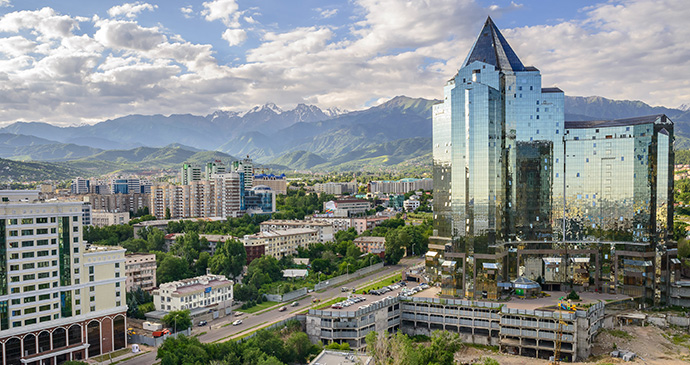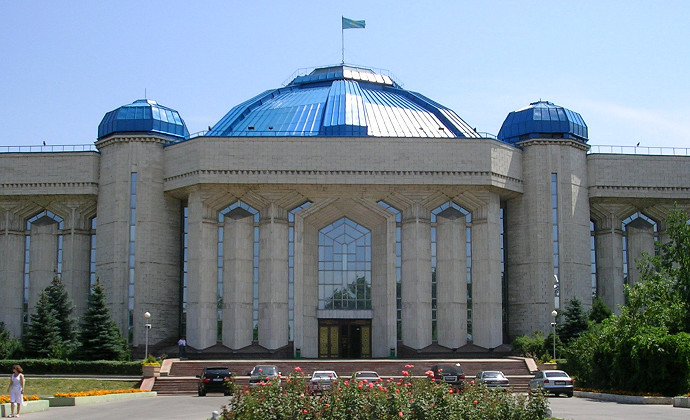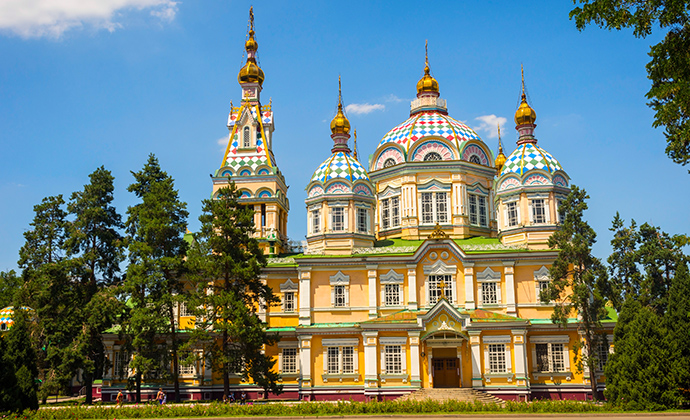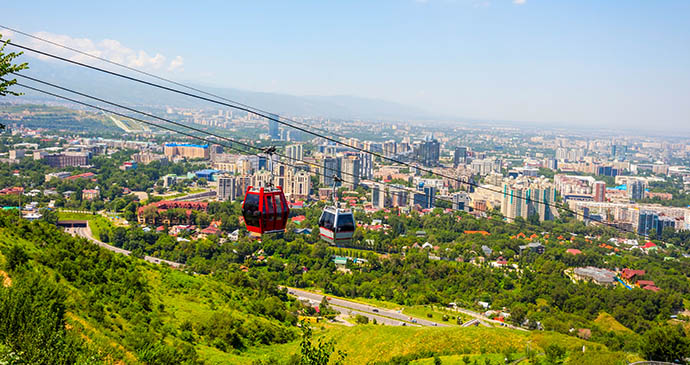The largest cosmopolitan hub in Kazakstan, Almaty is undoubtedly one of central Asia’s most exciting cities. Its stunning location adds much to its allure, sitting at the northern foot of the Zailysky Alatau range, the northernmost line of the mighty Tian Shan Mountains. Most visitors to the country will fly in to the city, but it deserves to be so much more than just a jumping-off point.
Although there is no attractive ‘old city’ (an earthquake in 1887 left just one brick building standing), there are plenty of interesting museums, attractive parks and intriguing buildings that shed light on Almaty’s Tsarist, Soviet and post-independence history. Here’s our round up of what not to miss during a weekend in the city.
Almaty’s modern cityscape is set against a striking mountain backdrop © EXPO-2017 National Company
Start your tour at Republic Square, the heart of administrative power in Almaty. This is the place to come on major holidays, when the square is closed off to traffic, and frequently hosts live music and firework displays. The south side of the square is dominated by the imposing pale-grey late Soviet bulk of the former Presidential Palace, now housing the municipal authorities. The focus of the north side is a post-independence addition, the graceful obelisk of the Independence Monument. This square-based structure, 18m in height, is topped by a replica of the Golden Man.
Almaty’s Central State Museum exhibits Kazakh historical, archaeological, cultural and political artifacts © Tisoiso CC-BY-SA
A short walk away, Central State Museum is Almaty’s largest museum. It is housed in a large blue-domed building constructed in the early 1980s, though as an institution the museum dates to the 19th century when it was founded in Orenburg. The large foyer, beneath the central dome, is enlivened by costumed mannequins depicting various periods in the early history of Kazakhstan.
From here, take Furmanov Street a block-and-a-half north, turning right at Abai Avenue. The first road on your left is the peaceful, leafy Tulebaev Street, its presence marked by a seated statue of the dinner-jacketed Mukan Tulebaev, looking every inch the classical conductor. The numerous plaques affixed to buildings along this street naming leading writers, scientists and politicians attest that this quiet lane in central Almaty was once a favoured address of the Soviet elite. Continuing further along Abai Avenue, you will arrive at building 85/105, home to the Kazakhstan Academy of Sports and Tourism, the oldest educational institution in the country.
Staying on Tulebaev Street, the House Museum of Mukhtar Auezov is a fascinating place to visit – even if you know nothing about the work of this important post-war Kazakh writer – for the insight it offers into the living standards of the intellectual elite in the Soviet Union of the 1950s. Turn into Kurmangazy Street to see a building built in the early 1970s to house the Kazakh Society of Friendship and Cultural Relations with Foreign Countries. Its circular conference hall apes the form of a yurt.
A little further east, you reach the vast orange-hued bulk of the Academy of Sciences building, constructed in the 1950s and apparently accommodating some 89,000m2 of floorspace. There are some pleasing fountains and statues in the gardens, while inside are housed various institutes and scientific organisations, as well as a few museums. These include the Kanysh Satpaev Memorial Museum (dedicated to the career of the first President of the Academy of Sciences) and the Archaeological Museum.
The Museum of Kazakh National Musical Instruments holds a collection of more than 1,000 instruments © Dan Lundberg CC-BY-SA
Two blocks north stands a pale-blue building decorated with tall Corinthian columns, home to the Republic Book Museum, which offers a good overview of Kazakh literature. Also worth checking out nearby, in an appropriately subterranean setting, is the Geological Museum: you descend in a slow cage-like lift into a museum space set out like a mineshaft.
Moving north along Dostyk Avenue to the heart of the city, you eventually reach Panfilov Park, which commemorates a general who became an icon of the Soviet Union for his exploits in defending Moscow during a fierce battle in 1941. Here is a huge war memorial, the Museum of Kazakh National Musical Instruments, and most notably the Cathedral of the Holy Ascension built in 1907 by architect Andrei Zenkov during a period in which the main building material of the earthquake-wary city was wood. It reaches a height of 44.1m, making it one of the tallest wooden buildings in the world. A few blocks to the southwest lies Old Square, dominated by the columned southern facade of the former House of Government, now the Kazakh–British Technical University.
Zenkov’s cathedral withstood many earthquakes including a major tremor in 1910 © Dinozzzaver, Shutterstock
From Old Square take Tole Bi Street westwards, turning left after five blocks on to Baitursynuly Street. You will see on your left after a couple of blocks the golden onion domes of St Nicholas Cathedral. The main tower, square in plan, is topped with five onion domes. A square-based bell tower sits to its west. Just to the south sits a yellow-walled bungalow amid well-tended grounds. This is the Baitursynuly House Museum and was the last home of the Kazakh writer Ahmet Baitursynuly, a victim of Stalin’s purges in 1938. A few blocks southwest stands the Kasteyev State Arts Museum. Opened in 1976, this is the most important art museum in Kazakhstan, and was renamed in honour of Kazakh painter Abylkhan Kasteyev in 1984. A statue of Kasteyev, holding a palette and sitting in front of an empty frame, lies in the grounds.
Kok-Tobe, or Green Mountain, can easily be accessed by cable car © Dinozzzaver, Shutterstock
Finally, don’t miss a trip up to Kok-Tobe (‘Green Mountain’), a natural viewing platform for the city that overlooks central Almaty from the southeast. The sausage-shaped summit of Kok-Tobe features observation balconies and is topped by a television tower, a mast 327m high, built in the early 1980s, which has become one of the symbols of the city. The best way to reach Kok-Tobe is by cable car from the city centre. The original was built by Georgian specialists in 1967 but this was replaced in 2016 by a French system that runs for 1,627m, departing from the south side of the Republican Palace of Culture.




